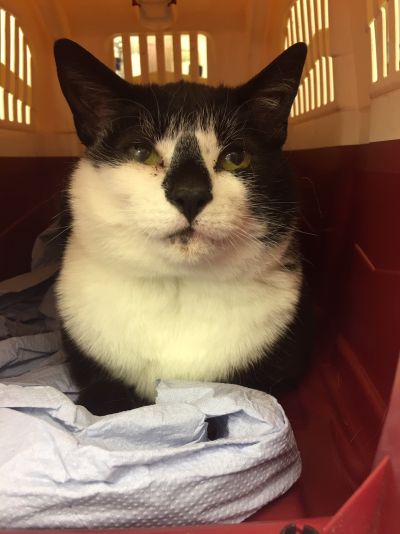
Posted By:
Farm cats are often a common sight amongst working farms – their ratting skills are invaluable at keeping rodent numbers down; a much needed pest control to limit disease, damage and loss of food stocks. Whilst keeping rat numbers low, it is very important to keep cat numbers well controlled also, so all farm cats should be neutered to limit their populations. In a lot of farms they are viewed as more than simple pest management, usually taking the role as beloved pet and receiving regular meals in the farmhouse. Inky is one such well loved farm cat, who unfortunately became severely injured when mixed up with a much more harmful rat catcher.
Inky the female spayed farm moggy loves nothing more than to play about the hay bales, stalking potential prey and watching all the work go on at the dairy. She often roams far and wide, and unfortunately one day ventured further afield into unknown territory and encountered a trap for rodents. Inky had been missing over night, but was eventually found with her paw stuck in the rat trap, unable to escape. Inky had obviously tried to get the food used as bait, when her foot became shut in, and she sadly must have been stuck out in the wet weather for several hours as when she was found she was very cold to the touch and poorly responsive.
Inky was rushed down to the practice immediately and was so unwell that it was thought she might have passed away on the journey. Fortunately, she was still alive by the time she was examined, but was found to be severely hypothermic, so much so that her body temperature didn’t register on the thermometer. Her body was shutting down – she wasn’t responding when prompted and couldn’t lift her head. Her front right paw was obviously injured but she was so unwell and in shock that she wasn’t even showing any pain from the trauma she had suffered.
There was major concern about the level of damage to Inky’s foot, and it was suspected that she would need her leg amputated as a salvage procedure. However initially she needed to be stabilised so was admitted to be hospitalised with pain relief, an intravenous fluid drip, and intensive nursing care to concentrate on slowly warming her up. After a few hours, Inky was in a suitable condition to have her foot X-rayed. Remarkably, the X-ray showed no damage to the bones in the paw – this gave her a chance of keeping her leg, and after antibiotic treatment she was left to recover in her kennel bed whilst being regularly monitored by the nurses.
Inky made a fantastic improvement throughout the day, improving in demeanour and alertness, taking food and even bearing weight on her injured paw well. The decision was made to discharge Inky home with strict room rest to recover with painkillers and antibiotics, and her owner was delighted. A couple of days later, Inky returned for a re-examination, and was generally improving, though she was now finding it difficult to walk on her back legs. The conclusion was reached that she had suffered nerve damage from struggling whilst being caught in the trap, and it was hoped that her hindlimb movement would recover.
The following week, she was using her back legs better, but had developed less of an appetite, and had begun to limp more on her injured paw. There was also quite a foul smell originating from the paw. Unfortunately, despite antibiotics, infection had set in where the trap had damaged the skin of the paw. Inky’s middle nails were beginning to die off, and she needed some sort of surgery to help her feel better. Inky’s owner really wanted her leg to be saved if possible, because of her active lifestyle on the farm and between the hay bales. The next day, Inky was admitted for surgery, and after being anaesthetised, her wound could be fully investigated. Inky’s middle toes needed to be removed, but there was enough of her paw that looked healthy such that she could hopefully keep her leg and avoid a limb amputation.
Diseased, infected tissue was inspected thoroughly and removed, with the exposed flesh flushed with saline solution. Healthy tissue within the rest of her paw was spared and stitched together. A dressing was placed by the nurses over her restitched paw which contained medical grade manuka honey, in the attempt to heal her wounds and prevent further infection. Inky recovered well and was discharged again, but would need to return to the practice every 48 hours to have her dressing removed and replaced. At each dressing change her wound was assessed and cleaned, but she was brighter in her self, eating better and using the leg well. After a little set back with some of her stitches and a bit of bone exposure from one of her toes, the wound began to heal at an impressive rate.
After a couple of weeks the wound was small enough that Inky was able to have her dressing removed. Inky would need to stay inside for at least another week, but after that time she could use her leg well enough that she could return to her farm lifestyle, and play in the hay barn once more, much to her owner’s delight!
Whilst on my visits I have been having several discussions...
As our feline friends get older there are a few conditions...
Another winter discussion group season is now behind...
©2024 Shepton Veterinary Group Ltd., All rights reserved.
Privacy Policy • Terms & Conditions • Cookie Policy